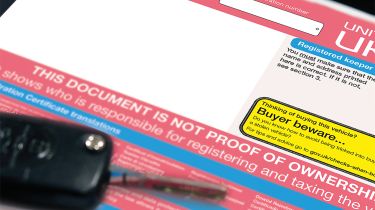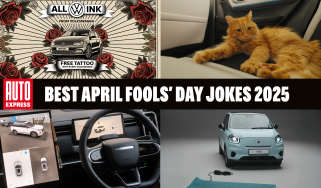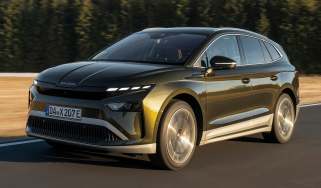What is a V5C? Vehicle log book rules for car buyers and sellers
We explain the V5C log book and the rules around it, whether you're selling or buying a car

Every vehicle that’s legally registered in the UK is issued with a V5C registration certificate by the Driver and Vehicle Licensing Agency (DVLA). This document is also commonly referred to as the ‘log book’, or by its old name ‘V5’.
The V5C certificate contains information about the vehicle itself, as well as its current keeper and number of previous ones. During your time as the registered keeper, you will need to store this document safely. When the time comes to sell your car, you can then use it to inform the DVLA about whether you’ve sold it on to another owner or trader, or if the car has been scrapped or exported outside the UK.
What’s on the V5C?
The V5C contains all of the important information about your car that is held by the DVLA on its database. This includes a wide range of data, including the car’s make, model, emissions class, tax rate and the date it was first registered.
All vehicles have the same style of V5C, whether it’s a moped or a 44-tonne truck. There may be some fields that aren’t filled out, though, depending on the type of vehicle that the V5C relates to.
There’s also some information included about the registered keepers of the vehicle. You can find the total number of former keepers, the current keeper’s address, and the date they acquired the vehicle.
One common misconception about the V5C is that it proves a person’s ownership of a vehicle. Take one look at the certificate, though, and you will see ‘this document is not proof of ownership’ written prominently on the front. The V5C only proves that the person named is the one responsible for registering and taxing the vehicle. This may be the owner, but it also may not.
What does the V5C log book contain?
Along with some summarised information on the front, there are six key sections that you’ll find within a V5C document. All of these sections are pre-stamped with the Vehicle’s registration number and the V5C’s reference number in order to prevent fraud.
- Vehicle details: This is a list of technical information about the vehicle, including the make, model, colour, fuel type, body type, engine size, vehicle identification number (VIN) and the date of first registration.
- Change my vehicle details: This is a form you can fill out to inform the DVLA of any incorrect or updated details about your vehicle. Major changes such as the body type, VIN number, engine, or paint colour can be declared here. You must then cut out this section and post it to the DVLA (the appropriate address is printed on the form).
- Selling or transferring my vehicle to a new keeper: If you are selling your car privately, the new keeper can fill in their personal details here. You will also need to inform the DVLA of the car’s mileage at the time of sale. Once you have sent this section off or notified the DVLA online, a new V5C will be sent to the new keeper’s address.
- Change my name or address, or both: If your personal details change for any reason (such as moving house, or a change of surname through marriage) you can inform the DVLA by using this form. A new V5C will then be issued with this updated information.
- Selling, transferring or part exchanging this vehicle to a motor trader: If you are selling your car to a trader (such as through a part-exchange or a car-buying service) you will need to fill out this form. This informs the DVLA about specific details such as the trader’s address and VAT number.
- Permanently exporting this vehicle for more than 12 months: If your car is leaving the UK, this form must be used to inform the DVLA of the date of export and the destination country.
- New keeper slip: It takes time for a new V5C log book to arrive in the post, so this small section needs to be filled out and handed over to the new keeper when you sell your car. This acts as a substitute until the new document is printed in the new keeper’s name. You must not send this section to the DVLA. If you acquire a new vehicle make sure you are given the slip, as you will need it in order to tax it.
Can I find my V5C online?
Even in the digital age, the V5C is strictly paper only so you won’t be able to find a copy online. However, you can still make some updates to it via the DVLA website, and this is usually a far quicker process than sending off sections of your V5C by post.

If you have sold your car, you can transfer ownership it to its new keeper online. In fact, this is recommended, as you must notify the DVLA immediately whenever a vehicle changes hands. You can also transfer the car to a trader using the online service.
If you do transfer the vehicle’s ownership online, a new paper V5C will be dispatched, but you must still hand over the completed new keeper slip from the old one.
When to update a V5C
There’s no requirement to routinely update a V5C document, but you will need to inform the DVLA and receive a fresh copy of the document if you change your personal details, transfer a cherished registration or make significant modifications to the vehicle.
Updates to your car’s V5C can be done online via the DVLA website or through the post. Online is often the quickest option of the two, but if you wish to change the address, this service is only available between 07:00 and 20:00. Failing to inform the DVLA of your new address could result in a fine of up to £1,000.
If you’re declaring a significant modification to the vehicle, you will need to supply supporting evidence to the DVLA. Examples of evidence include an invoice for the work, a written confirmation from a garage or an inspection report from your insurer.
What to do with the V5C when selling a car
When you sell a car, either online, through a dealer or at an auction, it's a good idea to include the service history and other documentation about the car's life. But the most vital piece of paperwork is the V5C log book.
The V5C will have all the information about the car that your potential buyer needs to know. It will also provide reassurance that the car is indeed yours to sell. Once you’ve been through the negotiating process and the deal is done, it’s time to inform the DVLA that the owner of the vehicle has changed. Thankfully this is a simple process regardless of who you’re selling it to.
Failing to keep the DVLA updated of any changes to the vehicle and its registered keeper could result in you accruing fines and penalties intended for the new keeper. You could also face a large fine from the DVLA itself.
Selling to a private buyer
Once the deal is done and an individual buyer has bought your car, you will need to fill out two sections of the V5C document (both of these are green in colour).
Firstly, the ‘selling or transferring my vehicle to a new keeper’ will need to be filled out in order to inform the DVLA about who the new registered keeper is, their address, and the date of the sale. This section will then need to be sent off to the DVLA immediately.
Secondly, the ‘new keeper slip’ will need to be cut out and handed over to the new keeper. This supplement, also known as the V5C/2, will act as an interim certificate until the new V5/C arrives in the post.
Once these sections have been taken care of, you’ll need to send what’s left of the old V5C back to the DVLA.
Selling to a trader
If you’re selling to a business such as a dealership or car-buying service, you will need to fill in the yellow ‘selling, transferring or part exchanging this vehicle to a motor trader’ section.
This section informs the DVLA about the trader’s name and business details, as well as the date of sale. This must also be sent off immediately at the time of sale.

Alternatively, you can perform both private and trade registration transfers online. This can help to speed up the process (as well as save you a few pennies on stamps) and all you will need is the vehicle’s registration number, the V5C reference number and a device with internet access.
Once the DVLA receives confirmation that the car has been sold, it will return any Vehicle Excise Duty (VED) overpayment, as road tax cannot be transferred between owners.
What you need to do with the V5C when buying a car
Once you’ve purchased your new car, ensure that the seller has filled out your details correctly in the new keeper section and then sends this off to the DVLA either online or by post. You should receive your own V5C within six weeks, and you must immediately check that the information displayed is correct. If there are any mistakes, use the blue ‘change my name or address, or both’ section to have these corrected.
In the meantime, keep hold of your ‘new keeper slip’ as this will allow you to tax the vehicle as soon as you have purchased it. If you’re caught driving without tax, you end up facing a very big penalty.
Owner vs registered keeper
It’s important to remember that the V5C is not proof of a car’s ownership. Instead it just states who the registered keeper is and who will be responsible for administration relating to any motoring offences related to the vehicle. When you buy or sell a car you must complete the V5C paperwork so it's part of the ownership transfer process, but don't take it as proof that the registered keeper owns the car.
A car could be owned by a finance company, a fleet operator or by another third party and the V5C would name the person who uses the car as the registered keeper. It is not advisable to buy a car that doesn't have a V5C document, but the presence of the V5C isn’t a guarantee that the seller is actually the owner.
Frequently Asked Questions
If computers aren’t your thing, the DVLA still accepts changes to the V5C document by post, although this will take longer to process and transact compared to the electronic system.
Did you know you can sell your car with Auto Express? Get the highest bid from our network of over 5,500 dealers and we'll do the rest. Click here to try Auto Express Sell My Car now...
Find a car with the experts










